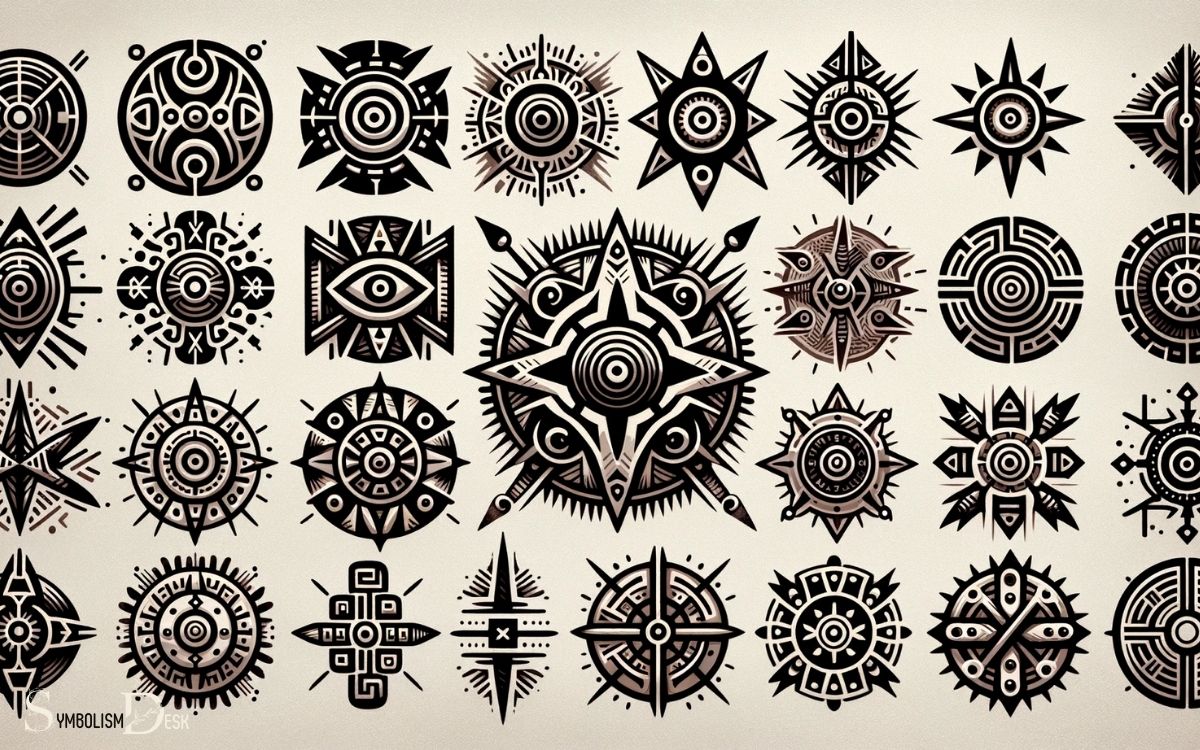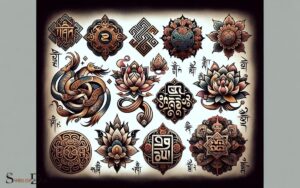Batok Tattoo Symbols and Meanings: Social Status!
The Batok tattoo, traditional to the indigenous people of the Philippines, is a form of body art that carries profound cultural and spiritual meaning. Each symbol and pattern used in Batok tattoos represents various aspects of the wearer’s identity, social status, and spiritual beliefs.
Batok tattoos are more than just body decorations; they are a visual language with each motif serving as a symbol of the wearer’s personal story or the communal values of their tribe.
For example:
- Python scales: Symbolize protection and guidance.
- Centipede motif: Represents warriors and bravery.
- Sun and stars: Often associated with the quest for glory and high status.
These symbolic patterns are traditionally etched into the skin using a hand-tapping technique with materials like thorns and bamboo sticks.
Batok tattoos narrate an individual’s life story, with each inked symbol a testament to their journey and heritage.

Key Takeaway
Origins of Batok Tattoos
The origins of Batok tattoos can be traced back to the indigenous tribes of the Philippines, where they held significant cultural and spiritual significance.
These tattoos weren’t just decorative; they were deeply intertwined with the tribe’s identity, beliefs, and traditions.
The art of Batok tattooing was passed down through generations, with each symbol and design carrying specific meanings and stories.
For these tribes, the tattoos were a way of connecting with their ancestors and were often used to mark important milestones in a person’s life, such as reaching adulthood or displaying feats of bravery.
The intricate patterns and symbols reflected the tribe’s connection to nature and their understanding of the spiritual world.
Understanding the origins of Batok tattoos provides insight into the rich cultural tapestry of the Philippines and the significance these tattoos held for the indigenous tribes.
This deep cultural significance paved the way for the development of traditional batok tattooing techniques.
Traditional Batok Tattooing Techniques
Traditional Batok tattooing techniques encompass a range of methods including hand-tapping and machine application, each with its unique cultural significance and aesthetic result.
Additionally, the sources of natural ink used in these traditional techniques contribute to the symbolism and meaning behind the tattoos.
Understanding these techniques provides valuable insight into the artistry and cultural significance of Batok tattoos.
Hand-Tapping Versus Machine
In traditional Batok tattooing techniques, artists create intricate designs by hand-tapping with a wooden stick and a small tool, as well as utilizing modern tattoo machines.
The choice between hand-tapping and machine techniques can impact the overall experience and outcome of the tattoo.
Here are some key differences to consider:
Hand-tapping:
- Involves a slower and more intricate process
- Allows for greater precision and control
- Emphasizes the cultural significance and traditional methods
- Tends to be more painful due to the manual nature of the process
Machine tattooing:
- Offers faster completion of the tattoo
- Provides a wider range of design possibilities
- Can be less painful for the recipient
- Incorporates modern technology into the traditional art form
The choice between these techniques can greatly influence the final result and the experience for both the artist and the recipient.
This contrast in techniques also impacts the selection of natural ink sources for Batok tattoos.
Natural Ink Sources
Natural ink sources play a crucial role in traditional Batok tattooing techniques, providing a connection to cultural heritage and symbolism. The use of natural materials for ink aligns with the indigenous beliefs and practices of the Philippines.
The table below illustrates some of the traditional ink sources used in Batok tattooing:
| Natural Ink Sources | Description |
|---|---|
| Charcoal | Charcoal is derived from burned wood and is used to create deep black ink. |
| Plant Juices | Various plant juices, such as aloe vera and turmeric, are used to produce vibrant colors like green and yellow. |
| Ashes | Ashes from specific plants are mixed with water to form gray ink, adding depth to tattoo designs. |
| Indigo | Indigo plants yield a blue pigment, often used in traditional tattooing for its symbolic significance. |
| Rice Wine | Rice wine is sometimes used as a diluting agent for ink, contributing to its fluidity and consistency. |
These natural ink sources not only serve as pigments but also hold cultural and spiritual significance within the Batok tattooing tradition.
Symbolism of Batok Tattoo Designs
Batok tattoo designs convey powerful symbols representing cultural heritage and personal identity. These symbols are deeply rooted in the traditions and beliefs of the indigenous people of the Philippines. Batok tattoo designs convey powerful symbols representing cultural heritage and personal identity. These symbols are deeply rooted in the traditions and beliefs of the indigenous people of the Philippines. Each design holds special significance, often narrating stories of bravery, social status, and ancestral connections. Kalinga tattoo symbols explained by practitioners and elders reveal that they serve as both protective emblems and markers of one’s journey through life. Today, these tattoos preserve a rich legacy, reconnecting individuals with their cultural roots.
The designs aren’t merely decorative but carry significant meanings that reflect the wearer’s connection to their community and the natural world.
The symbolism of Batok tattoo designs includes:
- Ancestral spirits: Representing reverence for ancestors and their wisdom.
- Nature elements: Depicting harmony with the environment and the interconnectedness of all living things.
- Tribal affiliation: Signifying belonging to a specific indigenous group and its customs.
- Personal achievements: Marking milestones and accomplishments in the individual’s life journey.
Understanding the symbolism behind Batok tattoo designs provides insight into the rich cultural tapestry of the Philippines and the profound significance of body art in indigenous communities.
Cultural Significance of Batok Tattoos
The cultural significance of Batok tattoos extends beyond individual expression, embodying the collective heritage and traditions of indigenous Filipino communities.
These tattoos are deeply rooted in the cultural identity of the Philippines, representing a connection to ancestry, bravery, and societal roles.
They serve as a visual record of an individual’s achievements and responsibilities within their community, reflecting a person’s status and accomplishments.
Additionally, Batok tattoos are a form of storytelling, preserving myths, legends, and historical narratives within the intricate designs.
The act of receiving a Batok tattoo is a rite of passage, marking important milestones in a person’s life and signifying their place within the community.
Furthermore, these tattoos carry spiritual and protective meanings, believed to provide strength, guidance, and safeguarding to the wearer as they navigate through life.
Evolution of Batok Tattoo Styles
Batok tattoo styles have undergone a significant evolution over time, reflecting changes in cultural practices and artistic influences.
The traditional styles, characterized by intricate patterns and symbolism, have given way to more modern interpretations that incorporate contemporary design elements.
Understanding the cultural influences that have shaped these changes provides valuable insight into the significance of batok tattoos in different historical contexts.
Traditional Vs. Modern Styles
When comparing traditional and modern styles of Batok tattoos, enthusiasts can observe a clear evolution in the techniques and designs used.
The transition from traditional to modern Batok tattoos has brought about several notable changes:
- Technique: Traditional Batok tattoos were hand-tapped into the skin using a bamboo stick, while modern styles often use electric tattoo machines for precision and efficiency.
- Design: Traditional Batok tattoos featured classic tribal motifs and symbols, whereas modern styles may incorporate more intricate patterns, realistic imagery, and fusion with other tattoo traditions.
- Color: Traditional Batok tattoos were typically monochromatic, using black ink, but modern styles may incorporate a wider range of colors for a vibrant and personalized aesthetic.
- Meaning: While traditional Batok tattoos held cultural and spiritual significance, modern styles may also reflect personal narratives and contemporary expressions.
This evolution reflects the dynamic nature of tattoo artistry and the interplay between tradition and innovation.
Cultural Influences Over Time
Evolving alongside cultural shifts, Batok tattoo styles have adapted to new influences and trends, reflecting the dynamic nature of this ancient art form.
Over time, various cultural influences have shaped the evolution of Batok tattoo styles, resulting in diverse and distinctive variations across different regions and communities.
The table below provides a snapshot of the cultural influences that have impacted the development of Batok tattoo styles.
| Cultural Influence | Description | Impact on Batok Tattoos |
|---|---|---|
| Indigenous Practices | Deeply rooted in tribal rituals | Incorporation of traditional symbols |
| Colonialism | Introduction of new design elements | Fusion of indigenous and colonial styles |
| Globalization | Exposure to diverse tattooing techniques | Integration of modern and traditional motifs |
These influences have contributed to the rich tapestry of Batok tattoo styles, showcasing the adaptability and enduring significance of this art form.
Sacred Meanings Behind Batok Symbols
The sacred meanings behind the Batok symbols are deeply rooted in the spiritual beliefs and cultural traditions of the indigenous communities.
These symbols hold significant spiritual and cultural importance, representing a connection to the ancestral spirits and the natural world.
The meanings behind Batok symbols vary across different indigenous groups, but they commonly convey themes of protection, strength, courage, and wisdom.
Each symbol is intricately linked to the community’s belief system and oral traditions, carrying stories of bravery, resilience, and guidance from the ancestors.
The intricate designs and patterns of the Batok symbols reflect the interconnectedness of the physical and spiritual realms, emphasizing the harmony between humans and nature.
Through these sacred symbols, the indigenous communities express their reverence for the spiritual forces that shape their lives.
- Batok symbols serve as a form of spiritual protection.
- They embody the virtues of strength and courage.
- Each symbol is imbued with ancestral wisdom and guidance.
- The designs reflect the interconnectedness of humans and nature.
Modern Interpretations of Batok Tattoos
Modern tattoo artists are incorporating traditional Batok symbols into contemporary designs to honor and preserve indigenous cultural heritage.
By integrating these ancient symbols into modern tattoo art, they are not only paying homage to the rich cultural traditions of the Philippines but also ensuring that these symbols continue to hold significance in the present day.
The fusion of traditional Batok motifs with modern tattoo techniques has resulted in a resurgence of interest in this ancient art form.
Through this creative adaptation, the meanings and stories behind Batok symbols are being shared with a wider audience, fostering a deeper appreciation for the cultural heritage they represent.
Conclusion
As the ancient art of batok tattoos continues to evolve, its sacred symbols and meanings remain deeply rooted in culture and tradition.
From the intricate designs to the spiritual significance, batok tattoos tell the story of an ancient practice that has transcended time.
The juxtaposition of traditional techniques and modern interpretations creates a visual tapestry that reflects the rich history and cultural significance of batok tattoos, preserving their legacy for generations to come.






